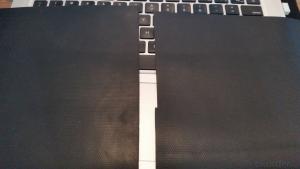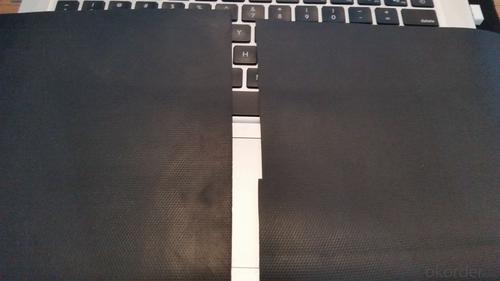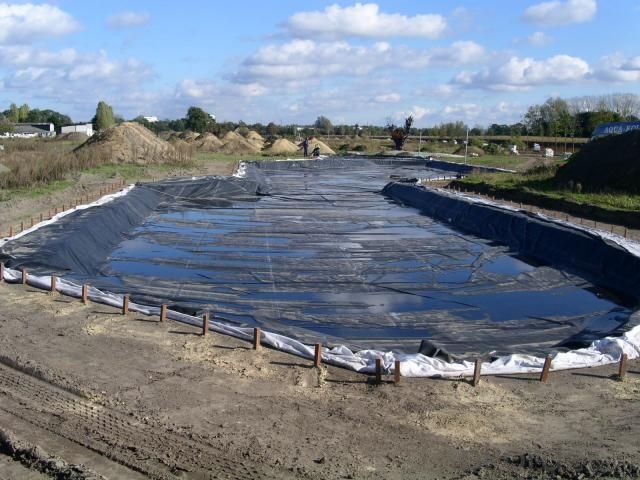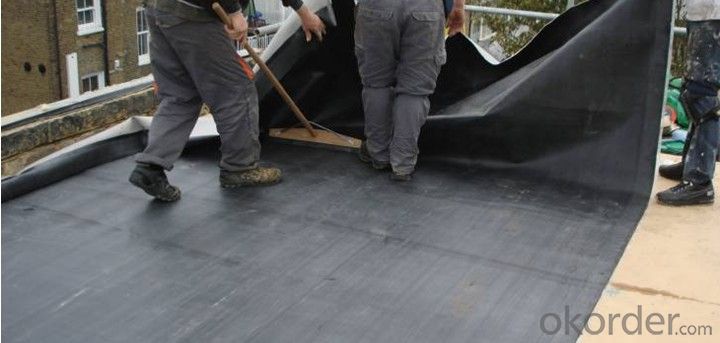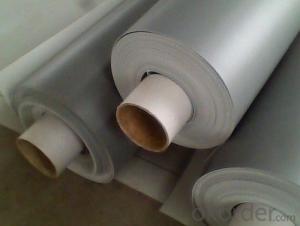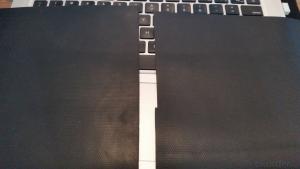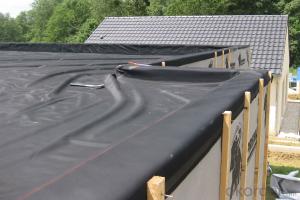EPDM Coiled Rubber Waterproof Membrane with Fabric Back
- Loading Port:
- Shanghai
- Payment Terms:
- TT OR LC
- Min Order Qty:
- 50000 m²
- Supply Capability:
- 5000000 m²/month
OKorder Service Pledge
OKorder Financial Service
You Might Also Like
EPDM Coiled Rubber Waterproof Membrane with Fabric Back
Description Of EPDM Coiled Rubber Waterproof Membrane with Fabric Back:
•EPDM waterproof sheet has excellent anti-ozone-aging performance, able to resist ultraviolet light and corrosion of many chemical corrosive materials in the atmosphere
•It has high tensile strength, high ductility and strong retractility, it has excellent crack resistance, able to effect waterproof function even with tiny vibration of buildings.
• Excellent resistance to ozone, oxidation and sunlight.
• Resistance to chemicals; resistant to most inorganic products.
Main Features of EPDM Coiled Rubber Waterproof Membrane with Fabric Back:
A.Polyester based SBS Modified Bitumen Waterproofing Membrane
a. Strong impermeability
b. High tensile strength, elongation, ability to adapt the grassroots shrinkage deformation and cracking
c. Puncture-resistant, broken resistant, tear-resistant
d. The corrosion resistance, resistance to mildew, weathering good
e. Construction convenient, hot-melt can be operated Four Seasons Construction, reliable joints
Specifications of EPDM Coiled Rubber Waterproof Membrane with Fabric Back:
| Material | EPDM Rubber |
| Size | 1.2m (width)*20m (length) or customized, weldable type 2.05m or 4m width |
| Thick | 1.2mm, 1.5mm, 2.0mm |
| Type | Vulcanized & Weldable |
| Pattern | Non-reinforced (homogeneous) |
| Certificate | ISO9001/14001 |
Applications of EPDM Coiled Rubber Waterproof Membrane with Fabric Back:
1. The substratum should be smooth, dry, clean, which can not have loosing and peeling phenomena.
2. Before application, clean up the basic level and eradicate the impurities.
3. Spread out the membrane on the substratum to loose sheet's stress. Use adhesive-glue to paint the substratum and the surface of membrane. When the adhesive is not sticky to hands, pave and press smoothly.
4. When pave the second volume of membrane, extrude 100mm of the edge of overlap of the first roll and do not paint with the adhesive. Pave the membrane on the substratum according to step so as to finish the whole pavement. When paving, do not tighten the waterproof membrane violently.
5. After that, use the special solvent to scrub the overlap joint. When it becomes fully dry , use the sheet glue to paint the both sides of the joint. Paint it again when it gets completely dry. Till the adhesive is not sticky to hands, press it smoothly and solidly.
6. Pay attention to fire prevention during application. Basement construction site shall be equipped with ventilation facilities
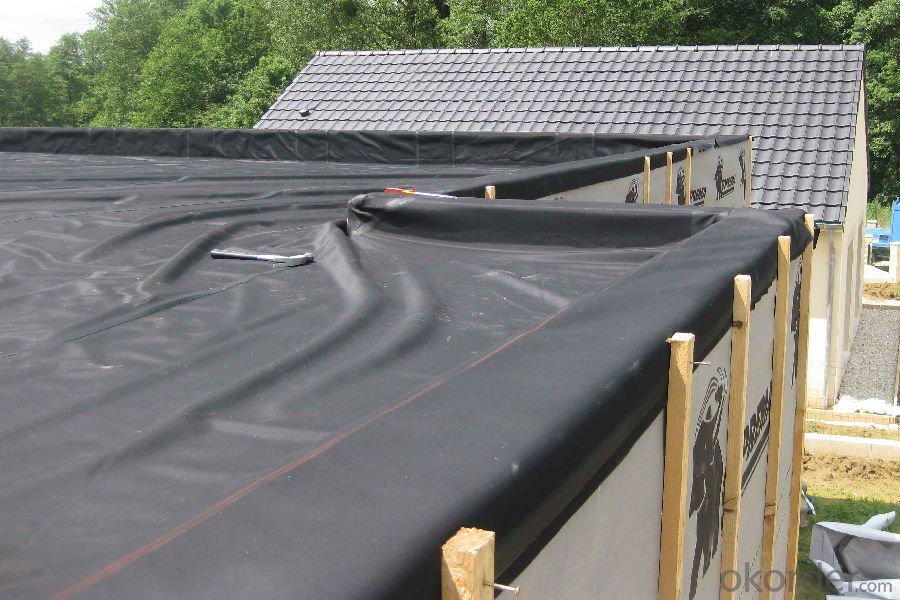
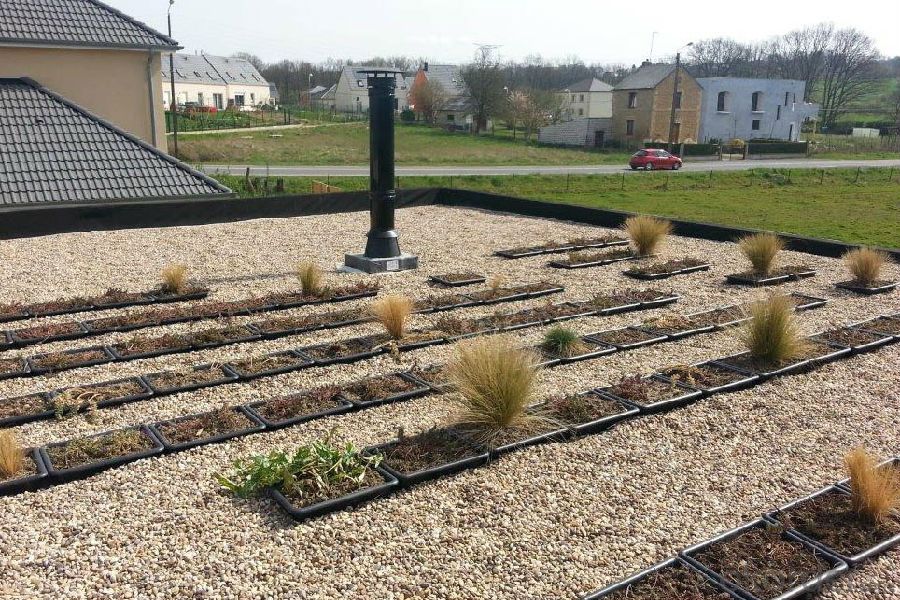
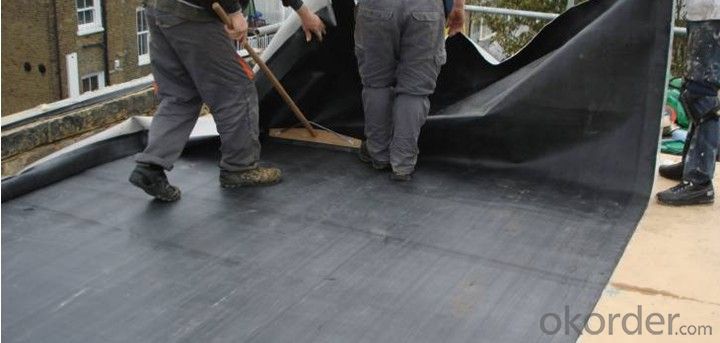
IMages of EPDM Coiled Rubber Waterproof Membrane with Fabric Back:
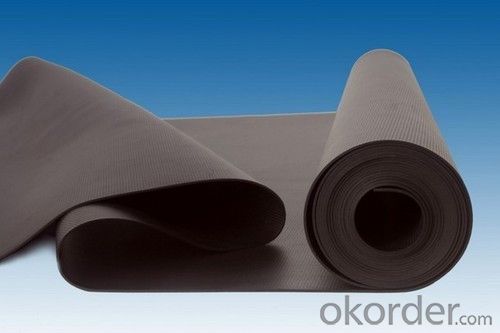
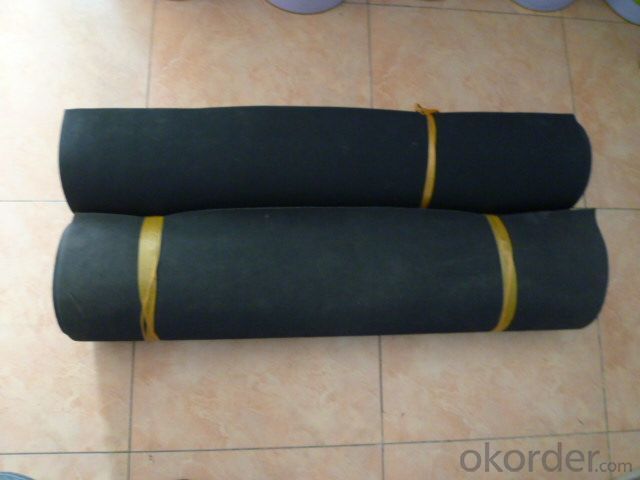
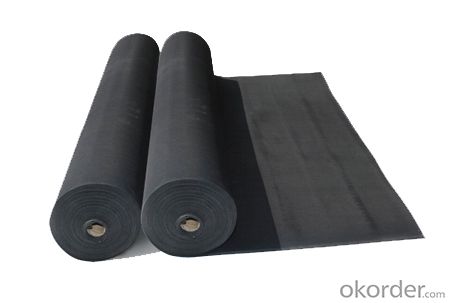
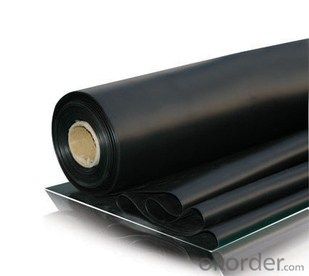
FAQ of EPDM Coiled Rubber Waterproof Membrane with Fabric Back:
1. What are we supplying?
We are specialized in producing Colorful Asphalt Roof Shingle, SBS/APP modified bitumen waterproof membrane, Self adhesive bitumen waterproof membrane, PVC waterproofing membrane, EPDM rubber roofing membrane, Single Component Polyurethane Waterproof Coating, and Spray Polyurea Waterproof Coating
.
2. How Many years experience do we have?
We have been exported to more than 20 countries in the past 15 years.
3. How long do we usually reply your request?
We always reply our customer within 24 hours.
- Q: Does a waterproofing membrane have any impact on the indoor air quality?
- Yes, a waterproofing membrane can have an impact on indoor air quality. It helps prevent water infiltration into the building, reducing the risk of moisture-related issues such as mold and mildew. By keeping moisture out, it helps maintain a healthier indoor environment with improved air quality.
- Q: How does a waterproofing membrane handle water migration through the substrate?
- A waterproofing membrane is designed to prevent water migration through the substrate. It acts as a barrier, preventing water from infiltrating the substrate and causing damage to the structure. The membrane is typically applied to the exterior side of the substrate, creating a watertight seal. To handle water migration, the membrane is typically made from a flexible and durable material such as modified bitumen, PVC, or EPDM. These materials have excellent waterproofing properties and can withstand exposure to water, UV rays, and other environmental factors. The membrane is installed in a way that ensures proper adhesion to the substrate, creating a seamless and continuous barrier. It is often applied in multiple layers to further enhance its effectiveness. The seams and joints are also properly sealed to prevent any potential water leaks. In addition to its primary waterproofing function, the membrane also helps to manage water that may accumulate on the surface. It is designed with a slope or drainage system, directing water away from critical areas and towards appropriate outlets or drains. Overall, a waterproofing membrane is specifically engineered to handle water migration through the substrate by creating a reliable and long-lasting barrier against moisture. It is an essential component in protecting structures from water damage and ensuring their durability and longevity.
- Q: Is a waterproofing membrane resistant to impact or abrasion damage?
- Waterproofing membranes are usually designed to resist impact or abrasion damage to some extent, but the degree of resistance can differ based on the membrane's specific type and quality. In general, waterproofing membranes are engineered to endure normal wear and tear, including minor impacts and abrasions. They are typically made from durable materials like modified bitumen, PVC, EPDM, or polyurethane, which offer a certain level of impact and abrasion resistance. These materials are selected for their ability to withstand external forces and safeguard the underlying structure against water infiltration. Although most waterproofing membranes can withstand moderate impacts and abrasions, they may not be completely impervious to severe damage. Heavy impacts or sharp objects have the potential to puncture or tear the membrane, compromising its ability to prevent water penetration. Hence, it is crucial to handle and maintain the membrane with care to reduce the risk of damage. To enhance the impact and abrasion resistance of a waterproofing membrane even further, additional protective layers can be added. For instance, a layer of geotextile fabric or a cementitious coating can be applied over the membrane to provide extra strength and durability. In summary, while a waterproofing membrane is designed to resist impact and abrasion damage, the level of resistance can vary depending on the specific type and quality of the membrane. It is important to choose a high-quality membrane and take appropriate measures to minimize the risk of damage for long-lasting waterproofing performance.
- Q: Can a waterproofing membrane be used in areas with chemical exposure, such as industrial settings?
- In industrial settings, a waterproofing membrane can indeed be utilized even in areas where chemical exposure is a concern. However, it is vital to carefully consider the compatibility of the chosen waterproofing membrane with the chemicals that are present. Different membranes possess varying degrees of resistance to different chemicals, hence the utmost importance of selecting a membrane that can endure the specific chemical exposure in the industrial setting. Furthermore, ensuring the proper installation and maintenance of the waterproofing membrane is crucial in order to guarantee its effectiveness and longevity in such environments. Regular inspections must be carried out, and any damage caused by chemical exposure should be promptly addressed through repairs or replacements. Ultimately, by making the right choice and consistently maintaining it, a waterproofing membrane can serve as an effective barrier against water and chemicals in industrial settings.
- Q: Can a waterproofing membrane be used on masonry surfaces?
- Yes, a waterproofing membrane can be used on masonry surfaces. It is a common practice to apply waterproofing membranes on masonry surfaces to prevent water penetration and protect the structure from moisture damage.
- Q: Can a waterproofing membrane be painted or coated?
- Yes, a waterproofing membrane can be painted or coated. However, it is essential to use a paint or coating specifically designed for use on waterproofing membranes. These types of paints or coatings are typically elastomeric, meaning they can stretch and move with the membrane without cracking or peeling. Additionally, the paint or coating should be compatible with the waterproofing membrane material to ensure proper adhesion and longevity. Before applying any paint or coating, it is advisable to clean and prepare the surface according to the manufacturer's instructions. It is also crucial to follow the recommended application process and allow sufficient drying and curing time for the paint or coating. Overall, painting or coating a waterproofing membrane can enhance its appearance, provide additional protection against UV rays and environmental elements, and extend its lifespan.
- Q: Are waterproofing membranes UV resistant?
- Yes, waterproofing membranes are typically UV resistant. They are designed to withstand exposure to sunlight without degrading or losing their effectiveness. This UV resistance helps to prolong the lifespan of the membrane and maintain its waterproofing properties over time.
- Q: Can a waterproofing membrane be used for wastewater facilities?
- Indeed, wastewater facilities necessitate a strong safeguard against the potentially harmful and corrosive effects of wastewater. By employing a waterproofing membrane, the infiltration of water, which can result in structural harm, deterioration, and contamination of surrounding areas, can be effectively prevented. Waterproofing membranes act as a barrier, shielding the facility's walls, floors, and foundations from the intrusion of water and moisture. This serves to uphold the structure's integrity, prevent leaks, and guard against corrosion stemming from the presence of chemicals in wastewater. Furthermore, certain waterproofing membranes not only safeguard against water and chemical damage but also exhibit resistance to UV rays, high temperatures, and freeze-thaw cycles. This is particularly significant for wastewater facilities situated in regions characterized by extreme weather conditions. All in all, employing a waterproofing membrane in wastewater facilities is a dependable and efficient means of ensuring long-term protection against water damage, preserving the structural integrity, and augmenting the facility's durability.
- Q: Can waterproof sheets be used on steel roof panels?
- Waterproof coils can be used on steel roof panels. Waterproof membrane: waterproofing membrane is mainly used for building walls, roofs, and tunnels, highways, landfills, etc.,
- Q: How long does it take for a waterproofing membrane to dry?
- The drying time for a waterproofing membrane can vary depending on several factors, such as the type of membrane, weather conditions, and application method. In general, most waterproofing membranes will require at least 24 to 48 hours to fully dry. However, it is important to consult the manufacturer's instructions for specific drying times as they may vary. Additionally, factors such as temperature, humidity, and ventilation can affect the drying time. It is recommended to ensure proper ventilation and allow sufficient time for the membrane to dry before subjecting it to any moisture or foot traffic.
Send your message to us
EPDM Coiled Rubber Waterproof Membrane with Fabric Back
- Loading Port:
- Shanghai
- Payment Terms:
- TT OR LC
- Min Order Qty:
- 50000 m²
- Supply Capability:
- 5000000 m²/month
OKorder Service Pledge
OKorder Financial Service
Similar products
Hot products
Hot Searches
Related keywords
